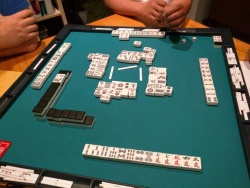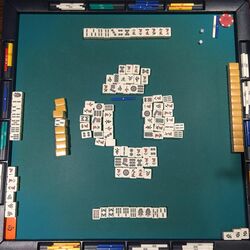Tochuu ryuukyoku: Difference between revisions
Tags: Mobile edit Mobile web edit |
(Seems redundant. Every abortive draws are optional.) Tag: Undo |
||
| Line 29: | Line 29: | ||
Of course, if the fourth riichi discard is not a winning tile, then the hand stops after that discard. As required with riichi declarations, all players must reveal their [[tenpai]] hands. Players without tenpai hands are punished with a [[chombo]] for declaring riichi while noten. If the hands are valid riichi calls, then the hand proceeds into the next hand, with an added [[honba]]. | Of course, if the fourth riichi discard is not a winning tile, then the hand stops after that discard. As required with riichi declarations, all players must reveal their [[tenpai]] hands. Players without tenpai hands are punished with a [[chombo]] for declaring riichi while noten. If the hands are valid riichi calls, then the hand proceeds into the next hand, with an added [[honba]]. | ||
== Suukaikan == | == Suukaikan == | ||
Revision as of 20:52, 15 April 2022

Tochuu ryuukyoku 「途中流局」 is more commonly known as an abortive draw. Specific game situations end a hand without any player declaring a win or drawing all tiles from the wall. With the exception of kyuushu kyuuhai, all cases of tochuu ryuukyoku are mandatory, when they occur.
Process
In the event of tochuu ryuukyoku, the current hand is instantly aborted. Furthermore:
- No points are exchanged between players; instead, the tiles are reshuffled again for the next hand.
- The noten penalty per exhaustive draw is not applied.
- Riichi declarers do not have to reveal their hand, except in face of four riichi.
- All riichi bets remain on the table and can be won during the next hand.
- As with an exhaustive draw, the honba count increases by one.
- Finally, the seat winds do not rotate for the next hand.
Essentially, play resumes as if the previous hand did not occur, except with the additional honba count.
Suufon renda
Suufon renda 「四風連打」 means "consecutively (ren) discarding (da) four (suu) winds (fon)". The hand is aborted when all four players' initial discards are the same wind type. In other words, every player started with hands containing the same wind; and each chose to discard that same wind tile. At the moment North plays the fourth tile, the hand is reset; and all tiles are reshuffled immediately for the next deal. Any tile calls would render this rule invalid as all four discards must be uninterrupted. Even so, it would not have been possible, as three out of the four required wind type ends up in one player's hand anyways.
Kyuushu kyuuhai
Kyuushu kyuuhai 「九種九牌」, literally means 9 (kyuu) kinds (shu) of honor or terminal (kyuu) tiles (hai). If a player's 14-tile hand after the initial draw is composed of 9 different honor or terminal tiles, the player may announce this and reveal the hand to abort the deal. It is essentially the game's invocation of the "Mulligan rule", commonly found in many card games. If any such tile is paired, then they are counted together as one, while invoking this rule. This option is only available if no tile call has interrupted the initial turn earlier. Instead of calling kyuushu kyuuhai, the player may play the hand normally, maybe aiming for kokushi musou or a terminal based yaku, such as chanta. This is the only case where the call for tochuu ryuukyoku is optional.
Suucha riichi
Suucha riichi 「四家立直」, literally means "four players riichi", is declared when all four players have declared riichi successfully. If the riichi declaration tile of the fourth player is a winning tile and claimed as such (ron), then the fourth riichi is not considered successful. The hand is not aborted and instead ends with the hand producing a winner, as usual.
Of course, if the fourth riichi discard is not a winning tile, then the hand stops after that discard. As required with riichi declarations, all players must reveal their tenpai hands. Players without tenpai hands are punished with a chombo for declaring riichi while noten. If the hands are valid riichi calls, then the hand proceeds into the next hand, with an added honba.
Suukaikan
Suukaikan 「四開槓」is declared when four quads are formed by different players. The rule literally means open (kai) four (suu) kans. If all four quads are called by one player, play continues to give the player the opportunity to score the yakuman, suukantsu. No other players are allowed to declare kan from then on. If the four quads have been formed by more than one player, hand abortion after formation of the fourth quad depends on the rules.
- Most rules abort the hand when the following discard is not a winning tile.
- Some rules end the game already on declaration of the fourth quad. If the fourth quad is robbed, the quad is not considered formed and ron is counted.
- Some rules may allow the game to go on, as if all quads had been declared by a single player. Afterwards, two rule options are available:
- No one may call kan again
- The ura dora indicator tiles are used starting from the fifth kan, in this case, no ura dora is available.
Sanchahou

Sanchahou 「三家和」, literally means "three (san) players (cha) win (hou)". If three players call ron on the same discard by the fourth player, the hand is aborted and no player wins. However, variable rules may allow the use of the "Triple Ron", where the one unfortunate player pays points to all three hands.
Rule variations
Any or all of the abortive draws may be subject to rule variations. Differences may point towards implementation and/or usage. Some game settings do not use any of the abortive draws, to either increase the game difficulty or to limit time wasting.
External links
- Tochuu ryuukyoku in Japanese Wikipedia